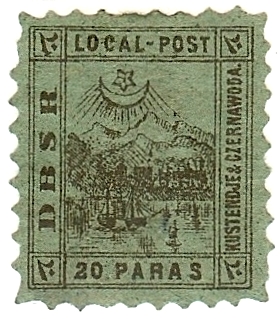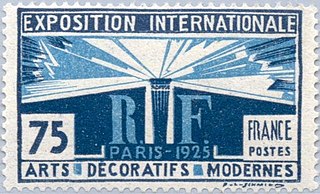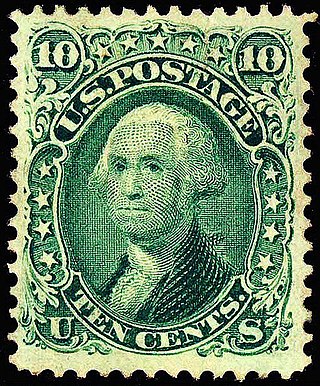
Philately is the study of postage stamps and postal history. It also refers to the collection and appreciation of stamps and other philatelic products. While closely associated with stamp collecting and the study of postage, it is possible to be a philatelist without owning any stamps. For instance, the stamps being studied may be very rare or reside only in museums.

A postage stamp is a small piece of paper issued by a post office, postal administration, or other authorized vendors to customers who pay postage. Then the stamp is affixed to the face or address-side of any item of mail—an envelope or other postal cover —which they wish to send. The item is then processed by the postal system, where a postmark or cancellation mark—in modern usage indicating date and point of origin of mailing—is applied to the stamp and its left and right sides to prevent its reuse. Next the item is delivered to its addressee.

A postmark is a postal marking made on an envelope, parcel, postcard or the like, indicating the place, date and time that the item was delivered into the care of a postal service, or sometimes indicating where and when received or in transit. Modern postmarks are often applied simultaneously with the cancellation or killer that marks postage stamps as having been used. Sometimes a postmark alone is used to cancel stamps, and the two terms are often used interchangeably. Postmarks may be applied by handstamp or machine, using methods such as rollers or inkjets, while digital postmarks are a recent innovation.

A cancellation is a postal marking applied on a postage stamp or postal stationery to deface the stamp and to prevent its reuse. Cancellations come in a huge variety of designs, shapes, sizes, and colors. Modern cancellations commonly include the date and post office location where the stamps were mailed, in addition to lines or bars designed to cover the stamp itself. The term "postmark" refers specifically to the part that contains the date and posting location, but the term is often used interchangeably with "cancellation" as it may serve that purpose. The portion of a cancellation that is designed to deface the stamp and does not contain writing is also called the "obliteration" or killer. Some stamps are issued pre-cancelled with a printed or stamped cancellation and do not need to have a cancellation added. Cancellations can affect the value of stamps to collectors, positively or negatively. Cancellations of some countries have been extensively studied by philatelists, and many stamp collectors and postal history collectors collect cancellations in addition to the stamps themselves.

The Inverted Jenny is a 24 cent United States postage stamp first issued on May 10, 1918, in which the image of the Curtiss JN-4 airplane in the center of the design is printed upside-down; it is one of the most famous errors in American philately. Only one pane of 100 of the invert stamps was ever found, making this error one of the most prized in philately.

Postal service in the United States began with the delivery of stampless letters whose cost was borne by the receiving person, later encompassed pre-paid letters carried by private mail carriers and provisional post offices, and culminated in a system of universal prepayment that required all letters to bear nationally issued adhesive postage stamps.

Postal history is the study of postal systems and how they operate and, or, the study of the use of postage stamps and covers and associated postal artifacts illustrating historical episodes in the development of postal systems. The term is attributed to Robson Lowe, a professional philatelist, stamp dealer and stamp auctioneer, who made the first organised study of the subject in the 1930s and described philatelists as "students of science", but postal historians as "students of humanity". More precisely, philatelists describe postal history as the study of rates, routes, markings, and means.

A local post is a mail service that operates only within a limited geographical area, typically a city or a single transportation route. Historically, some local posts have been operated by governments, while others, known as private local posts have been for-profit companies. Today, many stamp collectors operate hobbyists' local posts, issuing their own postal stamps known as "locals" or "cinderellas" for other collectors but rarely carrying any mail.

A Christmas stamp is a postage stamp with a Christmas theme, intended for use on seasonal mail such as Christmas cards. Many countries of the world issue such stamps, which are regular postage stamps and are usually valid for postage year-round. They usually go on sale some time between early October and early December, and are printed in considerable quantities.

In philately, the denomination is the "inscribed value of a stamp".

The Bicentennial Series was a lengthy series of American commemorative postage stamps.

The Canadian Postal Museum (CPM) was a museum once housed within the Canadian Museum of Civilization in Gatineau, Quebec. It was described by the Smithsonian Museum as being one of the five largest postal museums in the world, ranking second in annual attendance. The museum was not primarily about postage stamps, although it has a first-class collection that numbered in the tens of thousands. Rather, it presented the broader story of Canada's postal heritage, including the social and economic importance of postal communications throughout the country's history. It also explored international themes relating to postal communications.

The postal history of Turkey and its predecessor state, the Ottoman Empire, dates to the 18th century when foreign countries maintained courier services through their consular offices in the Empire. Although delayed in the development of its own postal service, in 1863 the Ottoman Empire became the second independent country in Asia to issue adhesive postage stamps, and in 1875, it became a founding member of the General Postal Union, soon to become the Universal Postal Union. The Ottoman Empire became the Republic of Turkey in 1923, and in the following years, its postal service became more modernized and efficient and its postage stamps expertly designed and manufactured.

Art Deco stamps are postage stamps designed in the Art Deco style, which was a popular international design style in the 1920s through the 1930s. The style is marked by the use of "geometric motifs, curvilinear forms, sharply defined outlines, often bold colors", and a fascination with machinery and modernity. This style strongly influenced contemporary architecture, furniture, industrial design, books and posters. Art Deco was named for after 1925 exhibit in Paris Exposition Internationale des Arts Décoratifs et Industriels Modernes. to which the American Topical Association has devoted a lengthy video. The exhibit lasted from April to October 1925 and displayed numerous objects in the new style. Examples of the style, however, are also found in the early twenties.
The Distinguished Americans series is a set of definitive stamps issued by the United States Postal Service which was started in 2000 with a 10¢ stamp depicting Joseph Stilwell. The designs of the first nine issues are reminiscent of the earlier Great Americans series, but less austere. The first nine issues were done with black lines on a white background, but in 2008, with the James A. Michener issue (#10), the USPS added color toning. Like the Great Americans series, the first twelve issues measured 0.84 inches by 0.99 inches overall, and were all designed by Mark Summers of Waterdown, Ontario. In 2011, with the Oveta Culp Hobby stamp, the series went to a larger format with full color images and colored backgrounds.

Presidents of the United States have frequently appeared on U.S. postage stamps since the mid-19th century. The United States Post Office Department released its first two postage stamps in 1847, featuring George Washington on one, and Benjamin Franklin on the other. The advent of presidents on postage stamps has been definitive to U.S. postage stamp design since the first issues were released and set the precedent that U.S. stamp designs would follow for many generations.
Puerto Rico topics have been featured on the stamps of Spain and of the United States. Spanish stamps are found at Postage stamps and postal history of Puerto Rico.

The history of Virginia through the colonial period on into contemporary times has been depicted and commemorated on postage stamps accounting for many important personalities, places and events involving the nation's history. Themes are particularly rich in early American and new nation history, historical landmarks, and Virginia-born presidents.

General George Washington at Trenton is a large full-length portrait in oil painted in 1792 by the American artist John Trumbull of General George Washington at Trenton, New Jersey, on the night of January 2, 1777, during the American Revolutionary War. This is the night after the Battle of the Assunpink Creek, also known as the Second Battle of Trenton, and before the decisive victory at the Battle of Princeton the next day. The artist considered this portrait "the best certainly of those which I painted." The portrait is on view at the Yale University Art Gallery in New Haven, Connecticut, an 1806 gift of the Society of the Cincinnati in Connecticut. It was commissioned by the city of Charleston, South Carolina, but was rejected by the city, resulting in Trumbull painting another version.
















